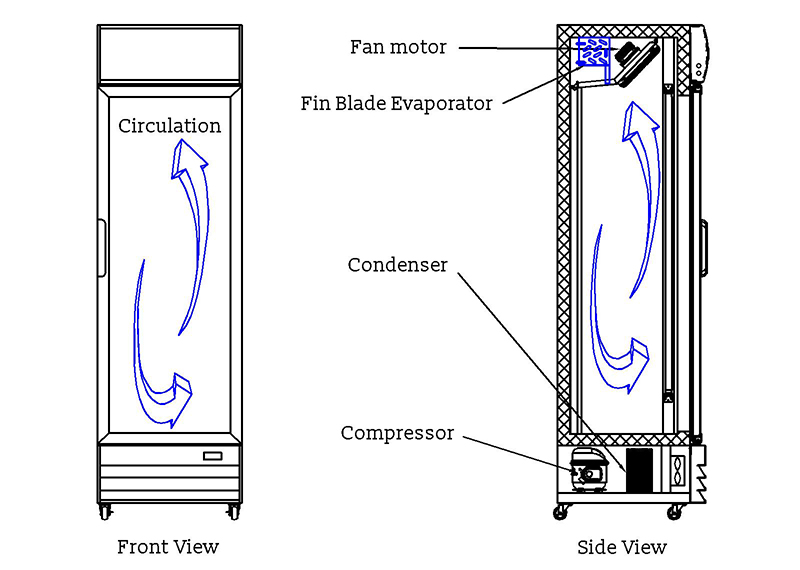Something about a cold drink makes it extra refreshing, whether it’s a frosty beer, a chilled glass of wine, or an ice-cold soda. But how do we keep our favourite beverages at the perfect temperature, ready to enjoy immediately? Enter the beverage refrigerator, the unsung home bar or the kitchen hero.
This article will deeply dive into the science behind beverage refrigerator cooling systems. We’ll explore the basics of cooling technology, the components of a beverage refrigerator, and the factors contributing to optimal cooling performance. We’ll also discuss how to maintain your refrigerator for peak efficiency and explore some of the latest innovations in the world of beverage refrigeration.
Understanding the Basics of Cooling Systems
Before diving into beverage refrigeration, it’s helpful to understand how cooling technology works. At its core, cooling relies on the principles of heat transfer. Heat always flows from hotter objects to cooler objects, so we need to remove heat to cool something down.
One of the most common methods of cooling is through the use of refrigeration systems. These systems work by circulating a refrigerant through components that remove heat from the surrounding air and transfer it outside the refrigerator. It cools inside the refrigerator, keeping your beverages at the perfect temperature.
The Components of Beverage Refrigerators
The heart of any beverage refrigerators are the compressor. It is the component responsible for compressing the refrigerant gas, increasing its temperature and pressure. From there, the refrigerant flows to the condenser, releasing heat to the surrounding environment.
After the refrigerant has been cooled down in the condenser, it flows through the expansion valve, which reduces its pressure and temperature. It causes the refrigerant to evaporate and absorb heat from the surrounding air. Finally, the refrigerant flows to the evaporator, which cools down the refrigerator’s air.
Refrigeration Cycle
The refrigeration cycle is the process by which refrigerant flows through a cooling system, absorbing and releasing heat. The cycle consists of four main steps:
Step 1: Compression and high-pressure refrigerant. The compressor comps the refrigerant, increasing its temperature and pressure.
Step 2: Heat dissipation in the condenser. The refrigerant flows to the condenser, releasing heat to the surrounding environment.
Step 3: Expansion valve and pressure reduction. The refrigerant flows through the expansion valve, which reduces its pressure and temperature.
Step 4: Cooling through evaporation in the evaporator. The refrigerant flows to the evaporator, which absorbs heat from the surrounding air and cools it down.
Refrigerants
The refrigerant is the substance that flows through the cooling system, absorbing and releasing heat to create a cooling effect. Commonly used refrigerants include Freon, R-134a, and R-410a. However, many of these refrigerants harm the environment, contributing to climate change and ozone depletion.
As a result, there is a growing shift towards eco-friendly refrigerants, such as hydrofluorocarbons (HFCs) and hydrocarbons (HCs). These refrigerants have a lower environmental impact and are becoming increasingly common in new cooling systems.
Design Considerations for Efficient Cooling
To achieve optimal cooling performance, there are several design considerations to remember. First and foremost, insulation is key. A well-insulated refrigerator will reduce heat exchange with the surrounding environment, allowing for more efficient cooling.
Airflow management is also important in maximizing cooling efficiency. Proper air circulation inside the refrigerator helps distribute the cold air evenly, ensuring that all beverages are cooled consistently. It can be achieved through strategically placed vents and fans within the refrigerator.
Additionally, the location and ventilation of the beverage refrigerator play a crucial role in its cooling efficiency. It’s essential to place the refrigerator away from direct sunlight and other heat sources to prevent unnecessary heat gain. Sufficient space around the refrigerator for proper airflow is also important to allow heat to dissipate effectively.
Energy Efficiency and Cooling Performance
Energy efficiency is a significant consideration when it comes to beverage refrigerators. These appliances are typically running continuously, so minimizing energy consumption can significantly impact both the environment and your electricity bills.
Understanding the energy consumption of a beverage refrigerator can be aided by looking for ENERGY STAR ratings. These ratings indicate that the refrigerator meets certain energy efficiency standards the Environmental Protection Agency (EPA) set. Choosing an ENERGY STAR-certified beverage refrigerator ensures you use a model designed to consume less energy while maintaining optimal cooling performance.
Advanced Cooling Technologies
Innovation has paved the way for advanced cooling technologies in beverage refrigeration. One such technology is thermoelectric cooling, which utilizes the Peltier effect to create a temperature differential and cool the beverages. Thermoelectric coolers are vibration-free and have no moving parts, making them a quiet and reliable cooling solution.
Conclusion
Beverage refrigerator cooling systems are an essential part of our lives, allowing us to enjoy perfectly chilled beverages whenever we desire. Understanding the science behind these cooling systems allows us to make informed choices when selecting and maintaining our beverage refrigerators.
From the basic principles of heat transfer to the intricate components that make up the refrigeration cycle, we have explored the inner workings of beverage refrigerators. We have seen how compressors, condensers, expansion valves, and evaporators work together to create a cooling effect that keeps our beverages at the ideal temperature.
Refrigerants have also been a focal point of our discussion, as we have learned about the shift towards eco-friendly options to reduce the environmental impact of cooling systems. As technology progresses, we can expect to see even more sustainable refrigerants being developed and integrated into beverage refrigerators.





More Stories
Dead Days unleash sonic fury with explosive single “ROT”
New Hampshire metalcore band In Shallows ignites with reflective anthem “World Fire”
Hot grindcore act Poolside At The Flamingo drops super heavy new track “Seething”